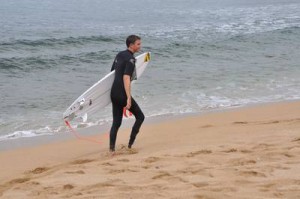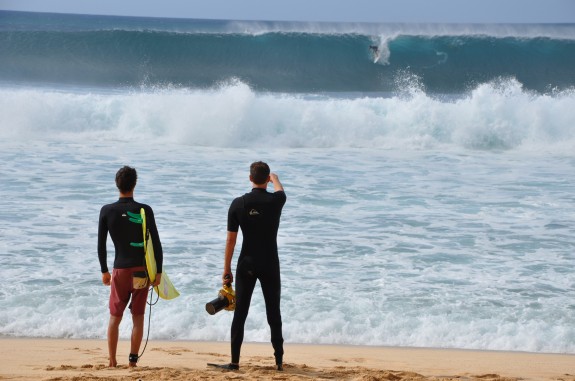SHARK WEEK INTERVIEW: Survivor on how he punched a tiger shark to stay alive

The beautiful island of Kauai is home to some of Hawaii’s largest and most picturesque surfing waves. For most people, the faraway location is a wonderful time to enjoy a vacation and swim in the warm waters of the Pacific Ocean. For Mike Coots, Kauai is home — a majestic stomping ground that affords him the opportunity to surf every day of the week.
But in October of 1997, the mirage abruptly faded away.
Coots and his buddies were surfing on the western side of the island around 7 a.m. Everything was going fine, and then it happened.
“We had paddled out, and a bunch of my friends caught a wave,” Coots said recently during a phone interview. “And I was going for the last wave of the set, and I kind of had been sitting there for a while stationary. And as soon as I got on my board and started paddling for the wave, a large tiger shark came up vertically and grabbed on to both my legs and started doing ragdoll, back and forth with its head.”
The attack, which will be highlighted on Discovery Channel’s Shark Week on Wednesday, Aug. 15 at 9 p.m., was vicious and life-changing. “I tried pushing it away,” he said. “That didn’t work. And I punched it a few times in its snout with my hand, and as soon as I did that, it let go and it went back underwater.”
The violence was over, but the realization seeped in. Coots’ right index finger “was split open like a potato” right down to the bone. That was the first visual sign of the tiger shark’s aftermath. After paddling back to shore from his location about 35 yards from the beach, the strange feeling of absence emerged.

“As I’m paddling in, my right leg started doing this spasm type thing,” he said. “I thought the shark was still after me. I looked over my shoulder, and my leg was just, you know, gone. It was a complete perfect amputation, just taken off. Didn’t feel it come off or anything. Had no idea my leg even came off. It was a painless ordeal, just a lot of pressure, a lot of intense like squeezing on my leg.”
After getting dragged up onto the beach by his friends, Coots’ buddy used a surfing leash as a tourniquet to stop the bleeding. From there it was a 10-minute journey to the nearby emergency room. Sitting in the back of a pickup truck, Coots went “in and out of consciousness.” His memories are hazy, but he remembers it was a school morning and mothers and children were on the road. It was a surreal moment: “The tailgate is down and my leg’s missing and blood’s going everywhere and seeing the look on their eyes. It was kind of bad. Pulled into the hospital, and as soon as I got in the hospital, went unconscious.”
A day later, he woke up with an amputated leg and discussions of getting a prosthetic. Still a teenager, his life was changed forever.
BACK TO THE WATER
Coots said his swim fin ended up washing ashore, right near a broadcast crew doing a live feed on the beach about his shark attack. “My foot was not in the fin,” Coots said, adding that the fin now resides in a California museum.
Thinking back to that fateful day, the diehard surfer said he knew almost right away that it was a large tiger shark. “The attack was maybe 4 seconds long,” he said. “It wasn’t something that felt like eternity. It was just this kind of quick thing. I remember looking down at it as it had my legs in its mouth. And I remember (the nose) being really, really wide … and really, really square, which distinguishes the tiger shark.”
The shark was estimated to be nearly 15 feet long, more than twice the size of an average adult human. “I’ve surfed that spot, and I’ve surfed at that time my entire life every single day, since as long as I can remember,” he said. “I just happened to be in the wrong place at the wrong time.”

Coots said he knows a few people who survived attacks, including his aunt and a friend’s father. Attacks are unusual, but not completely far-fetched. “I had seen a bunch of sharks spear-fishing and diving and stuff like that,” he said. “Hawaii is surrounded by water. We’re in the middle of the Pacific, so sharks are a pretty common thing.”
Even though he was thrown around like a ragdoll, Coots said the toughest part came during the rehabilitation process. “It was the start of our surf season when the waves get good, and all my buddies were out surfing every day all day,” he said. “And I’m sitting at home in this bed or going to these therapy things where I got to use these walkers and stuff, and not being able to surf. That was the hardest part about it. As weird as it sounds, when it happened, I had no idea what prosthetics were or anything like that. I thought, missing a leg, I’d never be able to walk again. Once I started doing some research and seeing people that could run around with these artificial legs, that kind of was like ‘Whoa.’ It was definitely an esteem-booster for me.”
Today, at the age of 32, Coots is back in the water. “I surf with (the prosthetic) pretty much every day,” he said. “I can do almost everything an able-bodied person can. I can’t really run too fast, or do long hikes, or anything like that. But I ride dirt bike. I do all kinds of things with it. It’s pretty amazing how your brain can adapt and it feels like it’s my regular leg. It doesn’t feel like a piece of metal or anything. It just feels like flesh and bone.”

Many people would be rightfully terrified to dip a toe in a body of water after a shark attack. Coots keeps everything in perspective. “I would be completely bored to death if I didn’t have the ocean,” he said. “It’s what I love and what I do. It definitely felt good to get back in the water the first time and still feels good every day to jump in.”
Plus, now it’s his job to get back in the water. “Being that first winter out of the water, the majority of it out of the water, a lot of my really close friends are professional surfers,” he said. “So I would take video cameras or still cameras and sit on the beach and film them, kind of as something to do to get out in the sun and stuff. And magazines kind of picked up on that and started running some of my things, and it really sparked my interest. … In Hawaii, there’s a lot of tourism-related jobs. For me, it was physically hard to wait tables or be a bus boy or you know valet. I couldn’t really run around and do all these things everybody else could. So I had to find a unique way to make a career in Hawaii. And, hey, it’s so beautiful over there, how could you not love photography?”
TURNING THE TABLES
Coots has also dedicated himself to saving the very thing that bit off his leg. His ordeal has given him time to reflect on marine life and the importance of the oceans. “I had no idea what was going on with shark finning, the practice of cutting off the fins and dumping the carcass over board,” he said. “(Sharks) play an absolute crucial role in our marine ecosystem and are invaluable to the health of our oceans. And without sharks being at the very top of the food chain, everything else below them will start to crumble. And at the rate that is happening right now with shark finning, it’s going to happen pretty soon.”
He credits Sharkwater, a documentary on shark finning, as his first entry point into understanding this marine crisis. His conservation efforts have also spilled over into Shark Week, Discovery Channel’s annual celebration of sharks. Coots’ story will be told on a program called Shark Fight (airing Wednesday, Aug. 15 at 9 p.m.).
“I feel very honored to be a part of Shark Week,” he said. “It’s a huge outlet and a huge medium for us to talk about our stories and talk about the positions we’re in to try and make change. And kind of give the public some knowledge of what’s happening and let them do their own research. And maybe in some way they could help out and maybe spark some young viewer’s interest in sharks or marine biology or the oceans. … By the time a viewer watches that hour-long program, 11,000 sharks will have been killed for their fin.”
By John Soltes / Publisher / John@HollywoodSoapbox.com
-
Shark Fight airs during Discovery Channel’s Shark Week programming. Tune in Wednesday, Aug. 15 at 9 p.m. Click here for more information.

